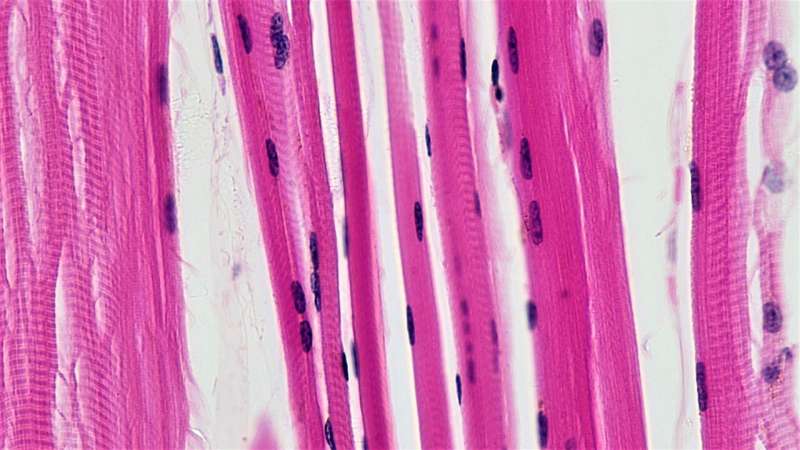Researchers find mechanism underlying muscle weakness in Becker disease

Muscle weakness in patients with Becker disease is caused by unusual electrical activity in muscle fibers termed 'plateau potentials' that make them temporarily inactive, says a study published today in eLife.
An understanding of these mechanisms and the ion channels involved may help the search for more effective therapies for weakness in Becker disease and other muscle diseases, and help understand how electrical activity is regulated in muscles.
Recessive myotonia congenita, also known as Becker disease, is a heritable skeletal muscle disease caused by mutated chloride channels in the muscles that do not work properly. People with the condition experience a phenomenon called myotonia whereby the muscles are hyperexcitable, meaning they are more sensitive than usual to activation. This results in stiff muscles that struggle to relax after being used.
After moving, patients can also suffer debilitating bouts of weakness that can last from seconds to minutes. "The mechanism underlying this weakness has remained a mystery since its initial description almost 50 years ago," explains first author Jessica Myers, a researcher at the Department of Neuroscience, Cell Biology and Physiology, Wright State University Boonshoft School of Medicine. "There are hints that weakness is due to hypoexcitability, or reduced sensitivity, of muscle fibers, but this conclusion is at odds with the discovery that muscle in Becker disease is hyperexcitable."
Myers and colleagues sought to uncover the mechanisms behind muscle weakness in patients by studying models of Becker disease in mice. They mimicked the disease by inactivating chloride channels either by genetically modifying them or by blocking them with a drug. They then measured how much force the muscles produced and the electrical activity within the muscle cells to see whether weakness was a result of hypo- or hyperexcitability.
The team found that the weakness was caused by temporary depolarisation of the muscle cells which they termed 'plateau potential'. At rest, muscle cells carry a negative electrical charge of -70 to -90 millivolts (mV) relative to their surroundings. When depolarised during a plateau potential, the charge reduces to a less negative state of between -30 and -45 mV which can last up to 100 seconds. Plateau potentials leave muscle fibers inexcitable, making them essentially inactive.
These results suggest that muscle affected by Becker disease rapidly cycles between hyper- and hypoexcitability as individual fibers switch from experiencing myotonia (causing stiffness) to the generation of plateau potentials (causing weakness), respectively. The state depends on the strength of the signal experienced by the muscle fibers: mild depolarisation triggers myotonia and more severe depolarisation triggers the generation of a plateau potential.
The team also demonstrated that both calcium and sodium ion channels are involved in creating a plateau potential, finding that sodium channels trigger this state while calcium channels are responsible for maintaining it. Moreover, blocking a subset of sodium channels with the drug ranolazine prevented the development of plateau potentials and eliminated the temporary muscle weakness.
"Further study is needed to identify all the ion channels involved in the generation of plateau potentials," concludes senior author Mark Rich, Professor at the Department of Neuroscience, Cell Biology and Physiology, Wright State University Boonshoft School of Medicine. "Doing so could lead to the development of novel therapies for weakness in Becker disease as well as similar diseases including periodic paralysis."
More information: Jessica H Myers et al, The mechanism underlying transient weakness in myotonia congenita, eLife (2021). DOI: 10.7554/eLife.65691




















